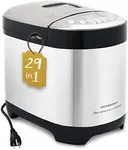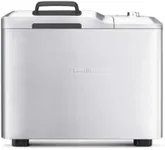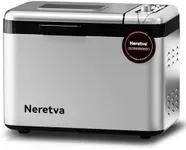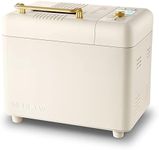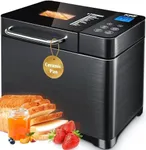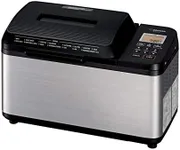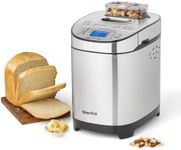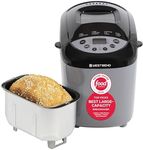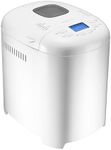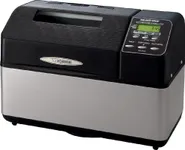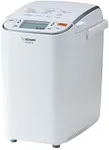Buying Guide for the Best Breadmakers
Choosing a breadmaker can make home baking much easier and more enjoyable, but with so many options available, it’s important to understand what features matter most for your needs. Start by thinking about how often you plan to bake, the types of bread you want to make, and how much space you have in your kitchen. By focusing on the key specifications, you can find a breadmaker that fits your lifestyle and helps you bake delicious bread with minimal effort.Loaf Size CapacityLoaf size capacity refers to the maximum weight of bread the machine can bake in one cycle, usually measured in grams or pounds. This is important because it determines how much bread you can make at once. Breadmakers typically offer a range of loaf sizes, such as small (around 500g), medium (750g to 1kg), and large (over 1kg). If you have a small household or bake infrequently, a smaller capacity may be sufficient. For larger families or frequent bakers, a machine with a larger loaf size is more practical. Consider your household size and how much bread you typically consume to choose the right capacity.
Number and Type of ProgramsBreadmakers come with preset programs for different types of bread and dough, such as white, whole wheat, gluten-free, or even jam and cake. The number and variety of these programs determine how versatile the machine is. Some machines offer just a few basic settings, while others have a wide range of options. If you like experimenting with different recipes or have dietary needs, look for a breadmaker with more program choices. If you mostly bake standard loaves, a simpler model may be enough.
Crust Color SettingsCrust color settings let you choose how light or dark you want the crust of your bread to be. This feature is important if you have a preference for a softer or crunchier crust. Most breadmakers offer at least three settings: light, medium, and dark. If you’re particular about crust texture or bake for people with different preferences, having adjustable crust settings can be very useful. Think about how you like your bread and whether this flexibility matters to you.
Delay TimerA delay timer allows you to set the breadmaker to start baking at a later time, so you can wake up or come home to freshly baked bread. This is especially convenient for busy schedules or for having bread ready for breakfast. Delay timers usually range from a few hours up to 13 or 15 hours. If you want the convenience of fresh bread at specific times, look for a breadmaker with a longer and easy-to-use delay timer.
Kneading PaddlesKneading paddles are the parts that mix and knead the dough inside the breadmaker. Some machines have a single paddle, while others have two for more thorough mixing. Removable or collapsible paddles make cleaning easier and can help reduce the hole left in the bottom of the loaf. If you want a more even texture or plan to make heavier doughs, consider a model with dual paddles. If easy cleaning is a priority, look for removable paddles.
Viewing WindowA viewing window is a clear panel on the lid that lets you watch the bread as it bakes. While not essential, it’s helpful for checking progress without opening the lid and disrupting the baking process. If you enjoy monitoring your bread or baking with kids, a viewing window can add to the experience. If you’re not concerned about watching the process, this feature may not be necessary.
Keep Warm FunctionThe keep warm function keeps your bread warm for a set period after baking is finished, usually up to an hour. This is useful if you can’t remove the bread immediately and want to enjoy it fresh. If your schedule is unpredictable or you like to bake overnight, this feature can help ensure your bread is still warm when you’re ready to eat.
Ease of CleaningEase of cleaning refers to how simple it is to clean the breadmaker after use. Features like non-stick bread pans, removable paddles, and dishwasher-safe parts make cleaning much easier. If you want to minimize cleanup time, look for these features. If you don’t mind a bit of extra effort, this may be less important.
